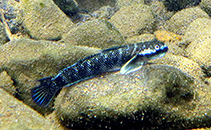| Diagnosis: |
Dorsal spines (total): 6-7; Dorsal soft rays (total): 9-10; Anal spines: 1; Anal soft rays: 9-10. Diagnosis: posterior tip of upper jaw extends to vertical level of anterior third, or half, of eye; single row of long, slender, unicuspid setiform teeth on upper jaw, 19-49 teeth on each half (left and right) of upper jaw, separated by median tubercle (Ref. 79590). Upper lip smooth (Ref. 57403, 79590), with an inner longitudinal furrow and a small, median tubercle (fleshy swelling)(Ref. 79590). Median notch in upper lip absent or small (Ref. 79590). 3 pores in preopercular canal; flanks with checker-board arrangement of small, light and dark patches (Ref. 57403, 79590).
Description: anterior teeth attached to opposite halves of upper jaw narrowly separated from each other by small, median fleshy swelling; each half of lower jaw with 1-8 caniniform teeth and 8-24 labial teeth; in adults, anterior labial teeth attached to opposite lower jaws separated broadly across mid-line by wide projection of soft tissue at dentary symphysis; 10-24 cycloid predorsal scales; 45-54 scales in longitudinal series (including 2 scales on caudal fin base); 13-20 scales in rearward transverse series; abdomen with cycloid scales, except sometimes absent immediately adjacent to ventral mid-line; 1st dorsal fin VI (rarely V), second dorsal fin I, 9-10, anal fin I, 9-10, pectoral fin 18-21 (usually 19-20), caudal fin with 15-18 segmented rays, 11-15 of which are branched; preopercular canal usually with 3 pores (M, N and O) but pore N is sometimes absent on one or both sides of the head (Ref. 79590).
Coloration: Preserved adults: head dark with numerous darker, round spots laterally; each scale light anteriorly and darker posteriorly, consequently body checkered with small light and dark patches, this pattern most distinct on flanks, giving them a spotted checkerboard appearance; ventral surface of body paler than flanks; 1st dorsal fin speckled dark, particularly along rays; 6th ray sometimes with 3 white spots; 2nd dorsal fin also speckled dark brown, with 4-10 white spots along each ray; anal fin dusky, with up to 6 white spots along each ray; pectoral fins speckled dark, with dark spots on base of fin and on rays; caudal fin speckled brown, often with 5-8 white spots along rays (Ref. 79590). Postlarvae and juveniles with dark pigmentation on head, vague bands of dark spots running obliquely across infraorbital and preopercular regions (this pattern is lost in adults); occipital and anterior dorsum with 3-4 dark bars and flanks with 7-8 vertical bands of dark pigment, most prominent dorsally; dorsal and caudal fins speckled with fine dark spots (Ref. 79590). |

